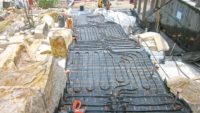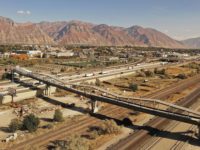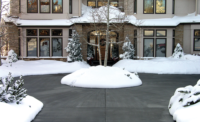Ever so slowly the market for commercial snow-melt systems continues to crystalize.
According to REHAU Commercial Project Manager Ryan Westlund, engineers and building managers of a facility that must reduce its chances for injuries are most proactive in having snow-melt systems.
“It’s getting very defined where people are using snow-melt,” he says. “It’s really come down to some key types of projects. It really sticks out for engineers in hospitals, helipads and outside airports. Places such as those, use snow-melt systems as risk mitigation, especially where there is a high volume of pedestrian traffic.”
John Sweaney, a product manager for Watts Water Technologies hydronic and electric snow-melt systems, says convincing key decision-makers that installing a system will help reduce any potential future issues.
“It’s still showing business owners that snow-melt is a great way to minimize the risk of litigation from slips and falls,” he says. “That’s always going to resonate with them.”
More control
The days of having a snow-melt system flip on and run continuously while the outside air temperature is at or below 32° F are through. If you take the Washington D.C. area as an example, according to Westlund, the temperature is 32° F or less for about 1,000 hours per year. Yet, it only snows for about 50 to 60 of those hours. That is an excessive amount of wasted energy.
Many operations include sensors, typically shaped like a hockey puck that can sense when the snow hits the ground, trigger the snow-melt system and remove the snow.
“With that we’re trimming down the hours of operations,” Westlund says. “But, it’s still a sort-of simple on/off switch.”
Westlund says the next evolutionary step is for sensors to predict when the snow will begin to fall. REHAU has worked with National Oceanic and Atmospheric Administration data and other weather predictors to help save energy created by snow-melt systems.
“Now we’ve tied our controls into the weather systems NOAA and data-gathering systems that are at most airports,” he says. “Our controls tie in with what they are forecasting in the area for the next four, five and six hours.
“We can stage the level of intensity need to warm of the slab on the percentage probability of snow. For example, if there is a 60% expectation of snow, we can run the system at 75% capacity. Or maybe even only 50% capacity.”
Westlund adds: “We’re moving toward optimized ramp-up times. Previously, no one was looking at incorporating online data, but now we’re at the point where it is the way to go. It’s cost-effective now, too. You probably couldn’t have done this in the early 1990s, but now we’ve brought the price points down and made the configurations easy to set up.”
Sweaney says the design and installation process has become much more refined in recent years. “It is a system approach,” he states. “It is not just about throwing tubing in the slab and cranking Btu there. It is critical to have the right controls so the system is effectively melting the snow, but also doing that in an efficient matter. That starts from day one of the design process.
In addition, Sweaney states finding new ways to fuel snow-melt systems are popping up.
“Over the last few years, more users are trying to utilize alternative energy sources for snow melting,” he says, “whether it’s a ground-source heat pump that can be utilized for cooling in the summertime and snow melting in the winter, or waste heat from a manufacturing facility.
“There is more focus on utilizing low-energy-cost heat sources--something other than a boiler that has been the traditional method, although condensing boilers are still a great choice.”
Greg Leupin of tekmar Controls, which was acquired by Watts in 2012, says running a system full-time can put unnecessary stresses on major sections of the system.
“With the introduction of modulating condensing boilers, you no longer have to run extremely hot to satisfy the loads,” he says. “A lot of snow-melting systems are designed to turn it on and dump all the heat out there, but that causes all kinds of side effects. It causes damage to the heat plant, sometimes dramatically shortening the life span. It also causes damage to the slabs.”
Splitting up the pie
In large-scale commercial snow-melt systems, Westlund believes the trend of creating more zones in the design will play a major role going forward.
“If you have a system that has, say, six or seven zones, they all don’t have to come on at once,” he states. “A reason for that in large commercial buildings is shading. You might have a building blocked on the southern side by another building where the shadow covers a portion (of the ground). You can easily draw the system with hydronic circuits to allow certain areas to come on while not running the full system.
Leupin thinks that zoning opens up a lot of possibilities for both designers and end-users. “Zoning makes a lot of sense because you can use an existing boiler or much smaller boiler and create a snow-melt system in stages,” he says.
A “snow-less” future
After a majority of the country underwent – and starts to think about a repeat of – the Polar Vortex, would it be a possibility for REHAU or Watts Water to provide cities and roads fully functional snow-melt systems?
It is not out of the realm of possibility. Westlund reports REHAU provided the ski resorts in Vail, Colo., with large applications. The largest system is installed at Solaris and that won the company a Plastics Pipe Institute Building and Construction Division 2011 “Project of the Year” award.
Leupin says that many Scandinavian cities utilize snow-melt in the high-use areas. He also believes with the growing use of geothermal and alternative energy sources, snow-melting city centers in North America is becoming a more realistic possibility each passing day.
“We’ve been involved in projects such as off-ramps on highways, which are important because of changing speeds,” he says. “Bridges and runways at airports are becoming more frequent projects.
“Snow-melting on these types of projects is very beneficial at the end of the day because you’re saving so much time and cost associated with snow plows and snow removal.”





